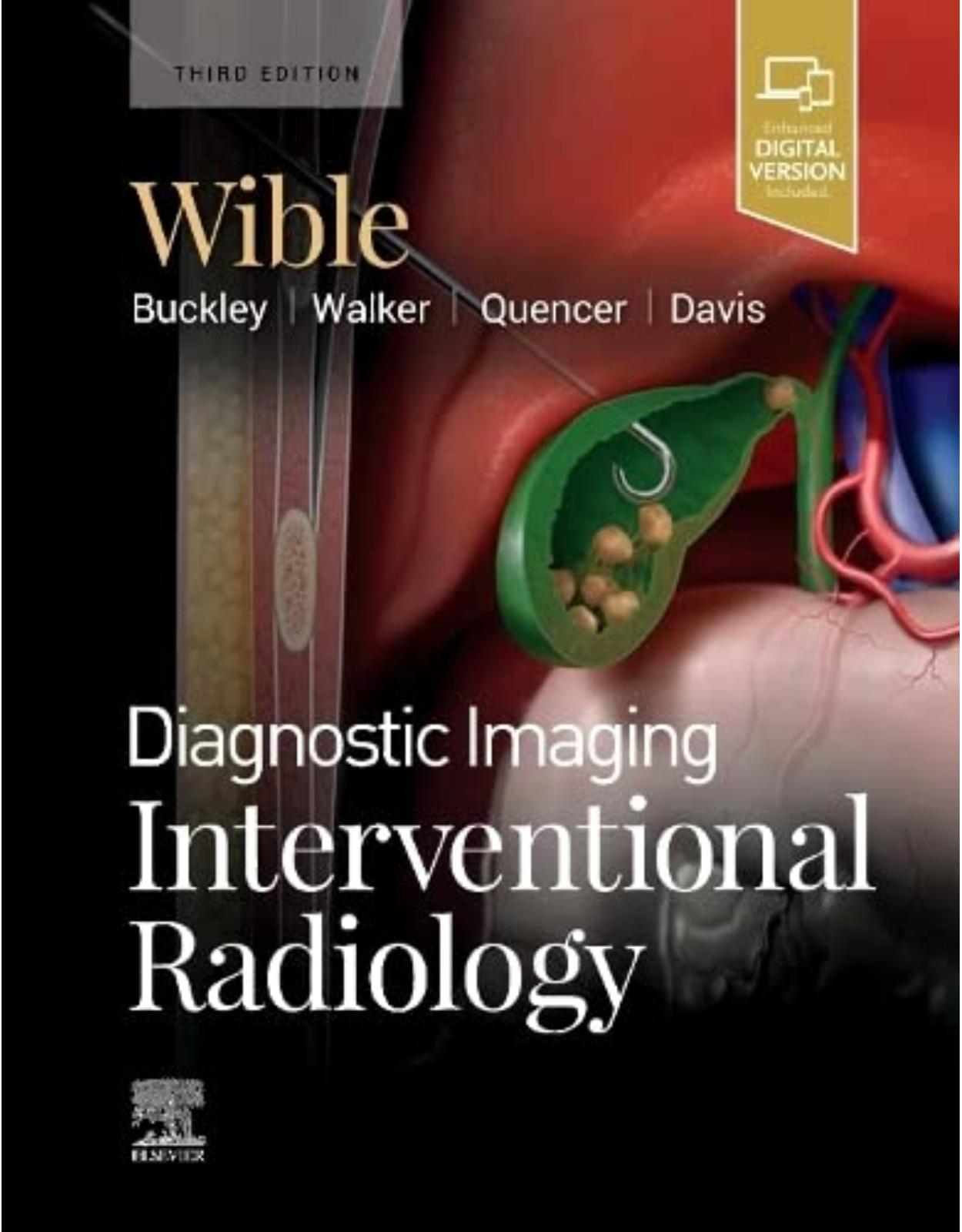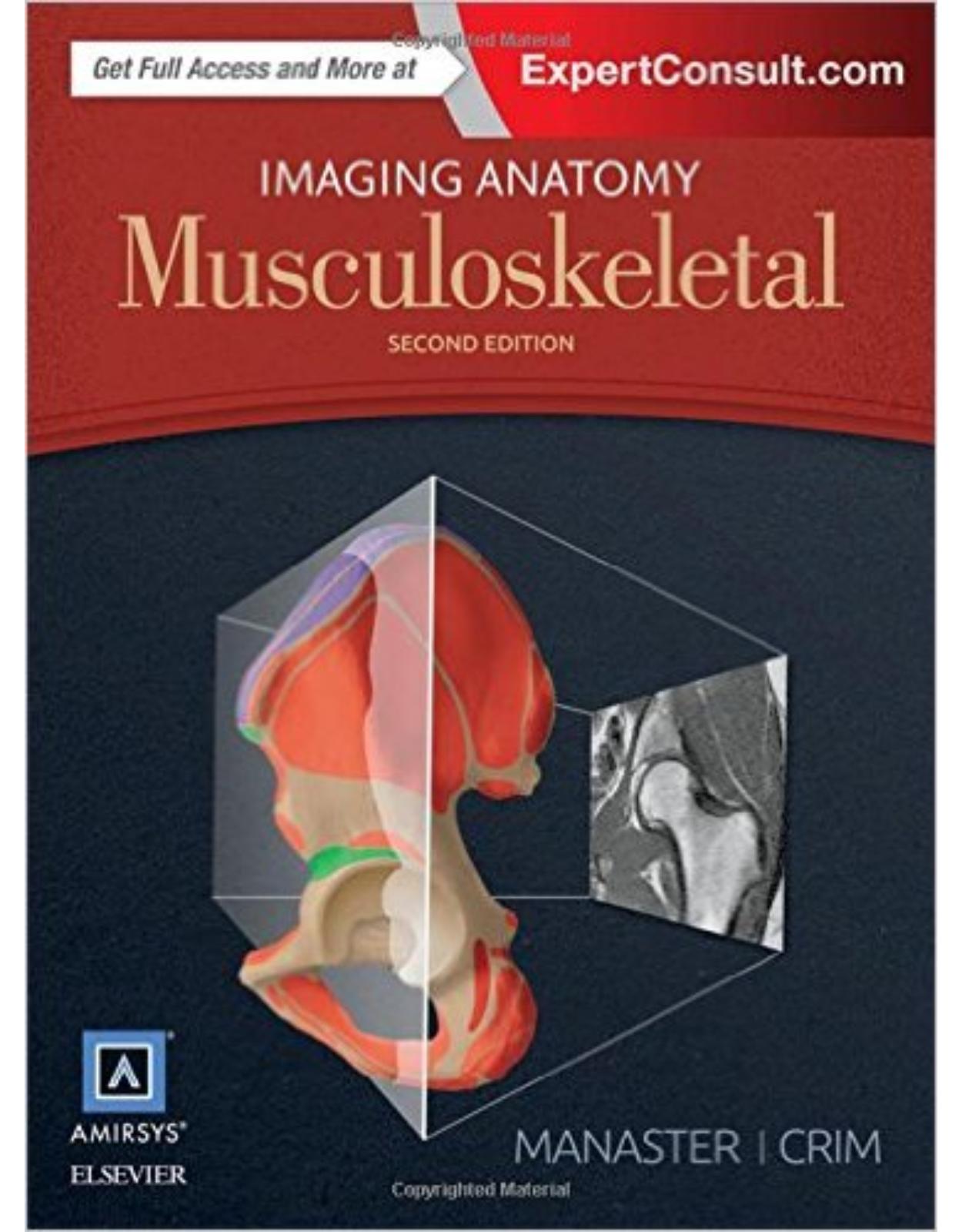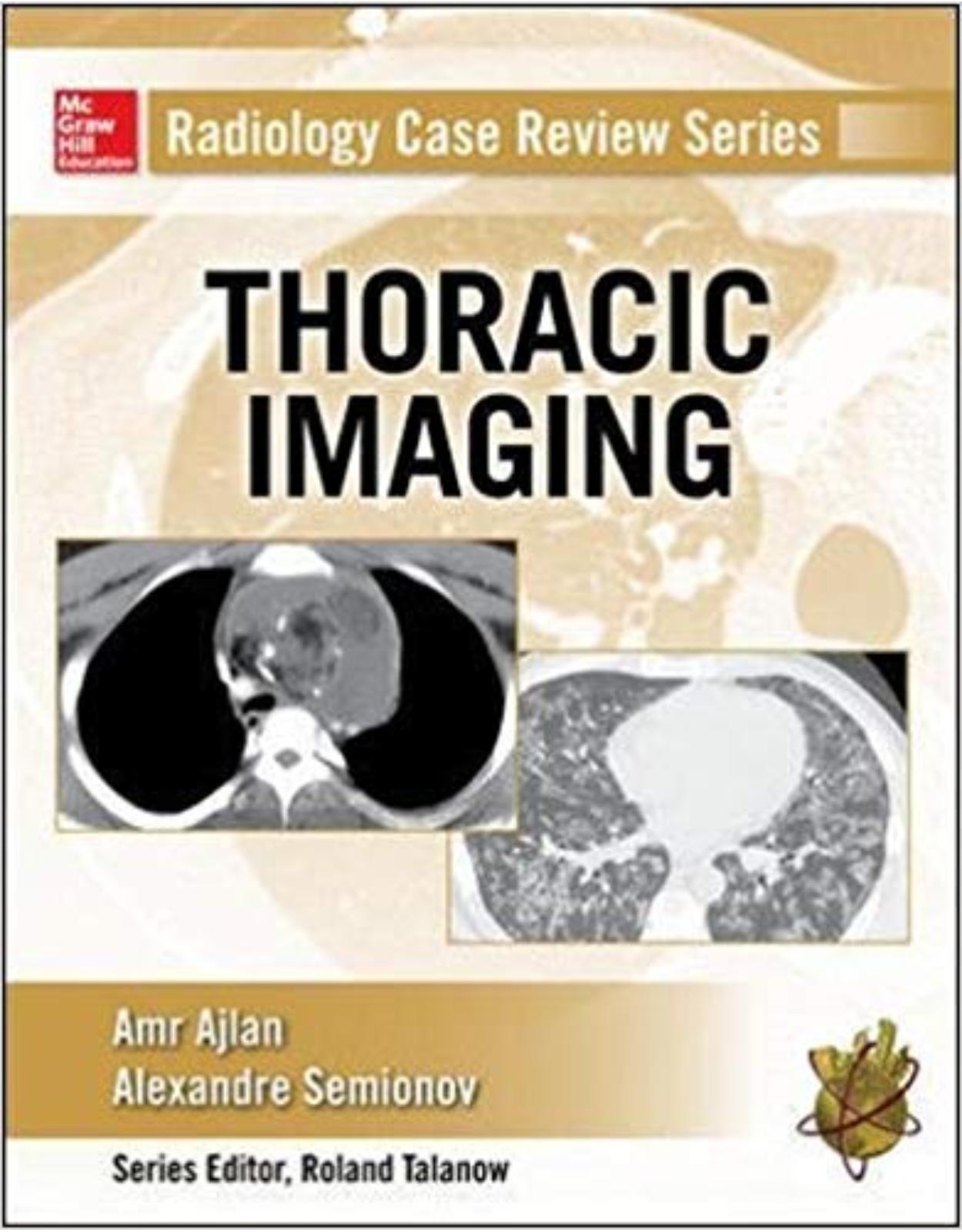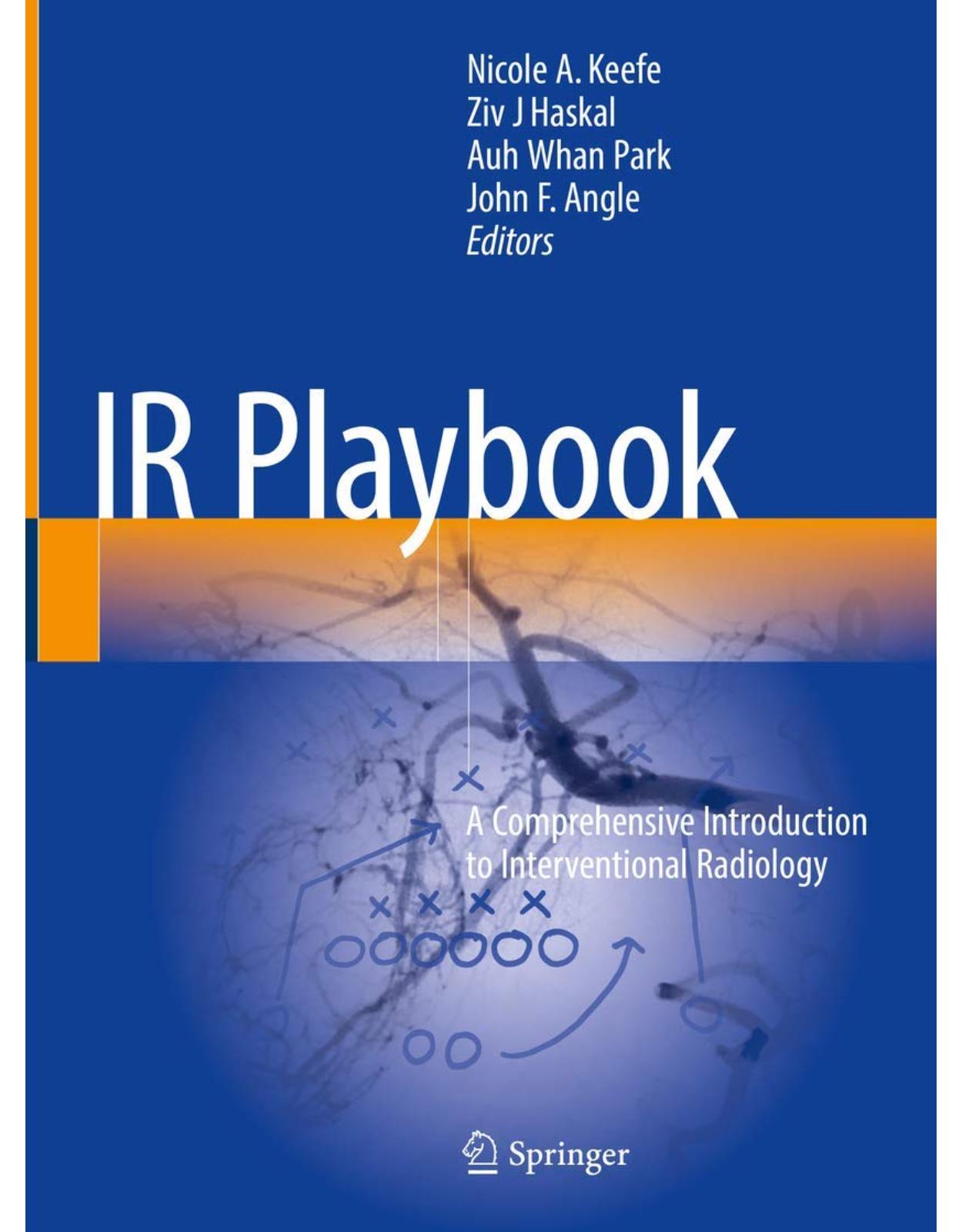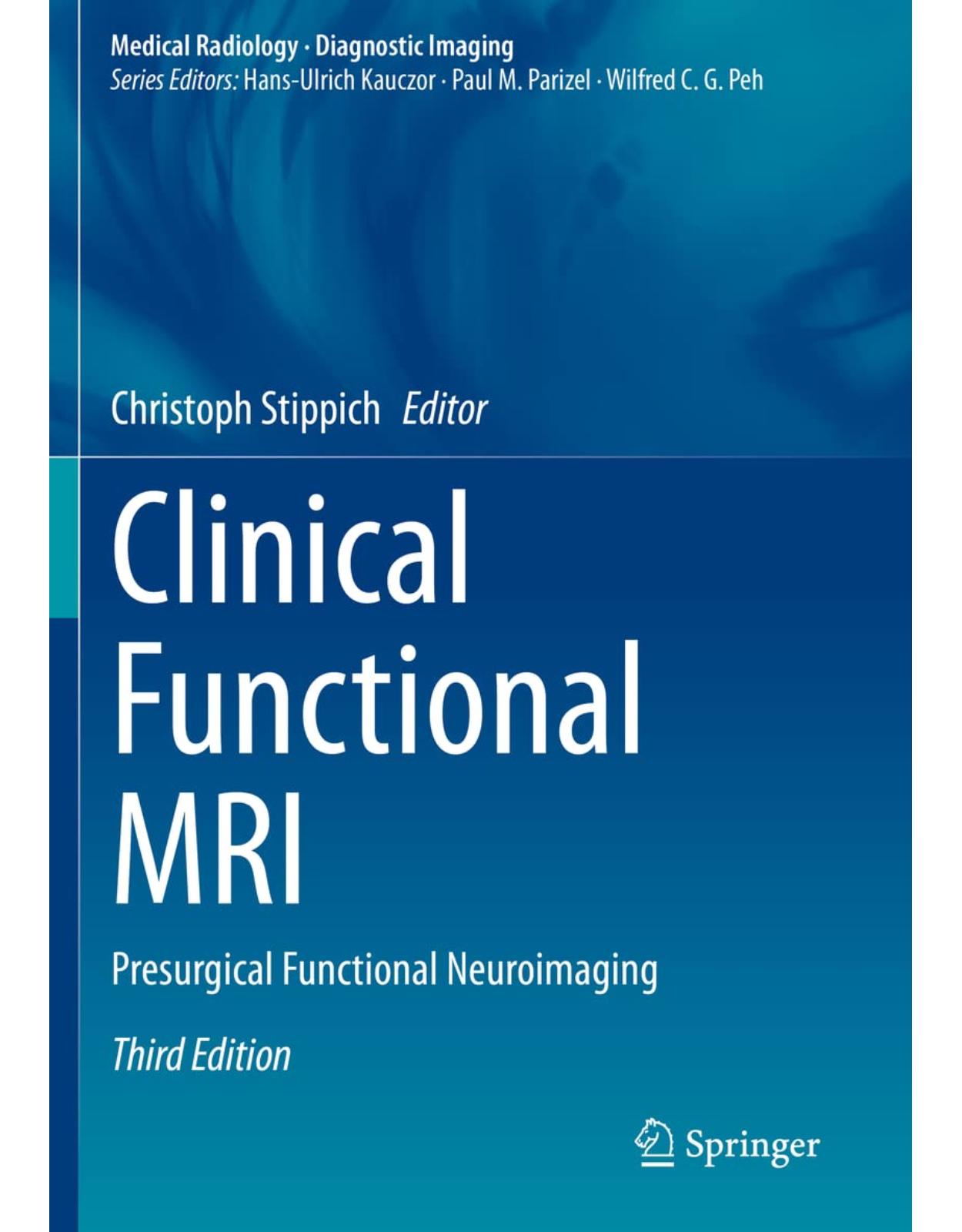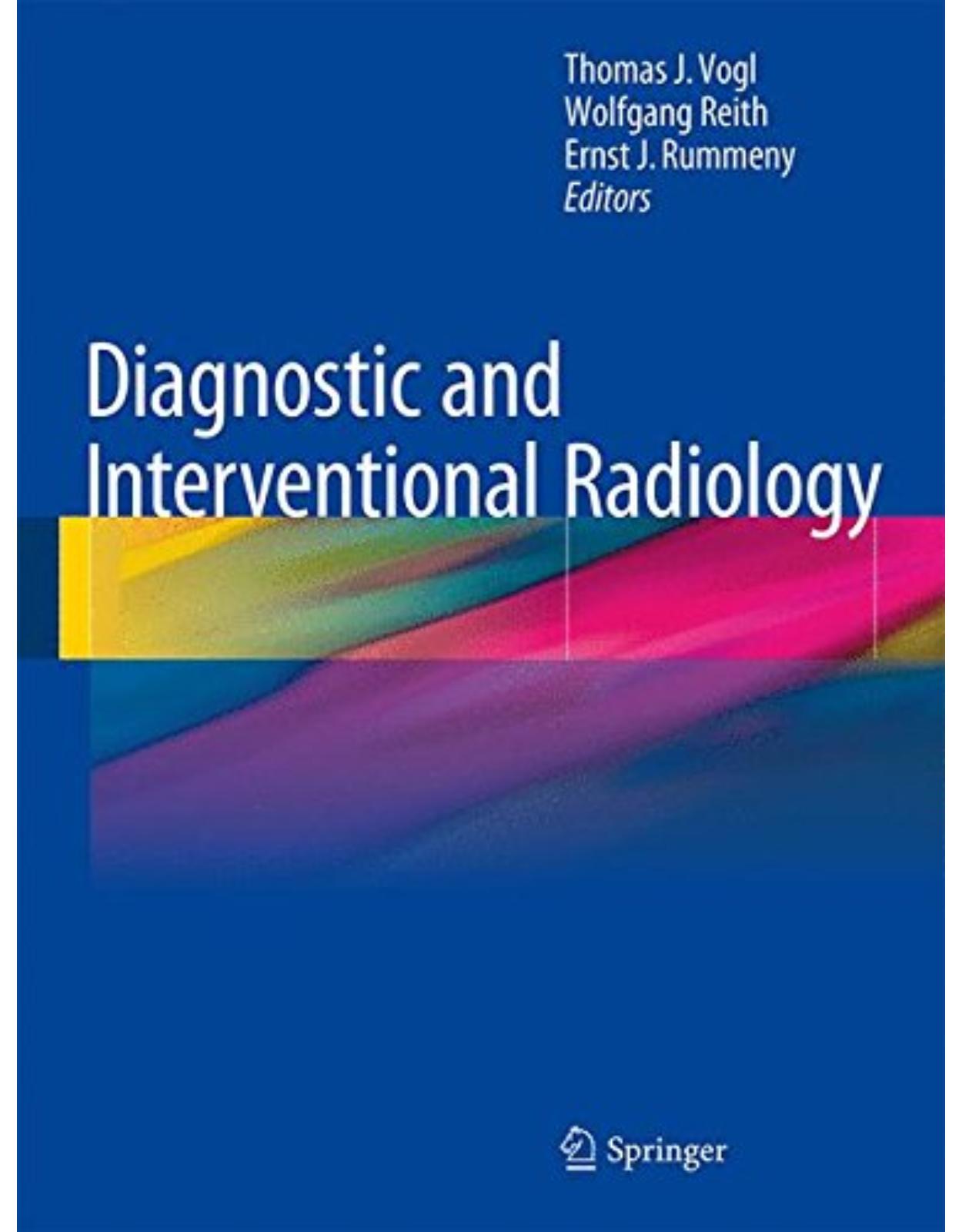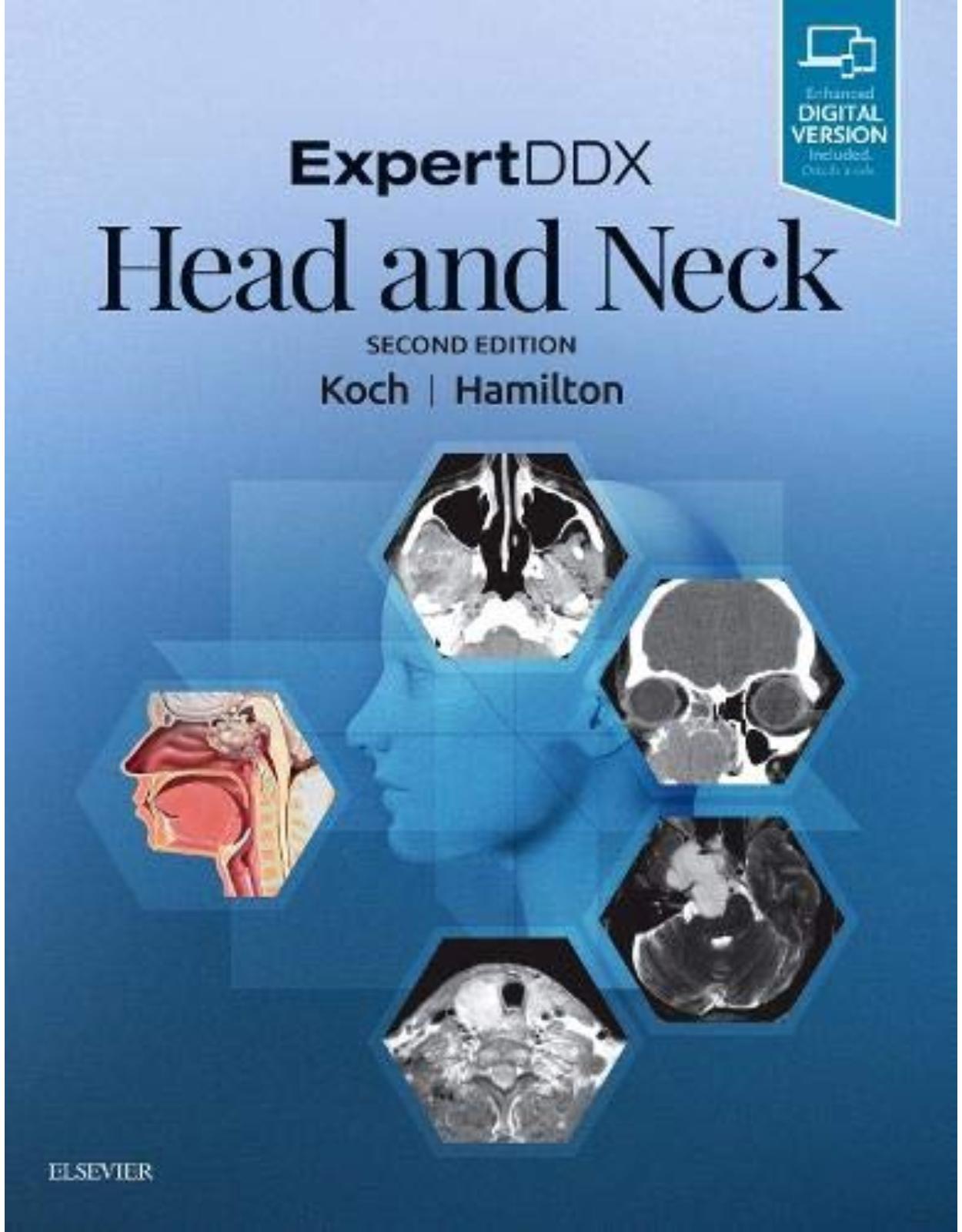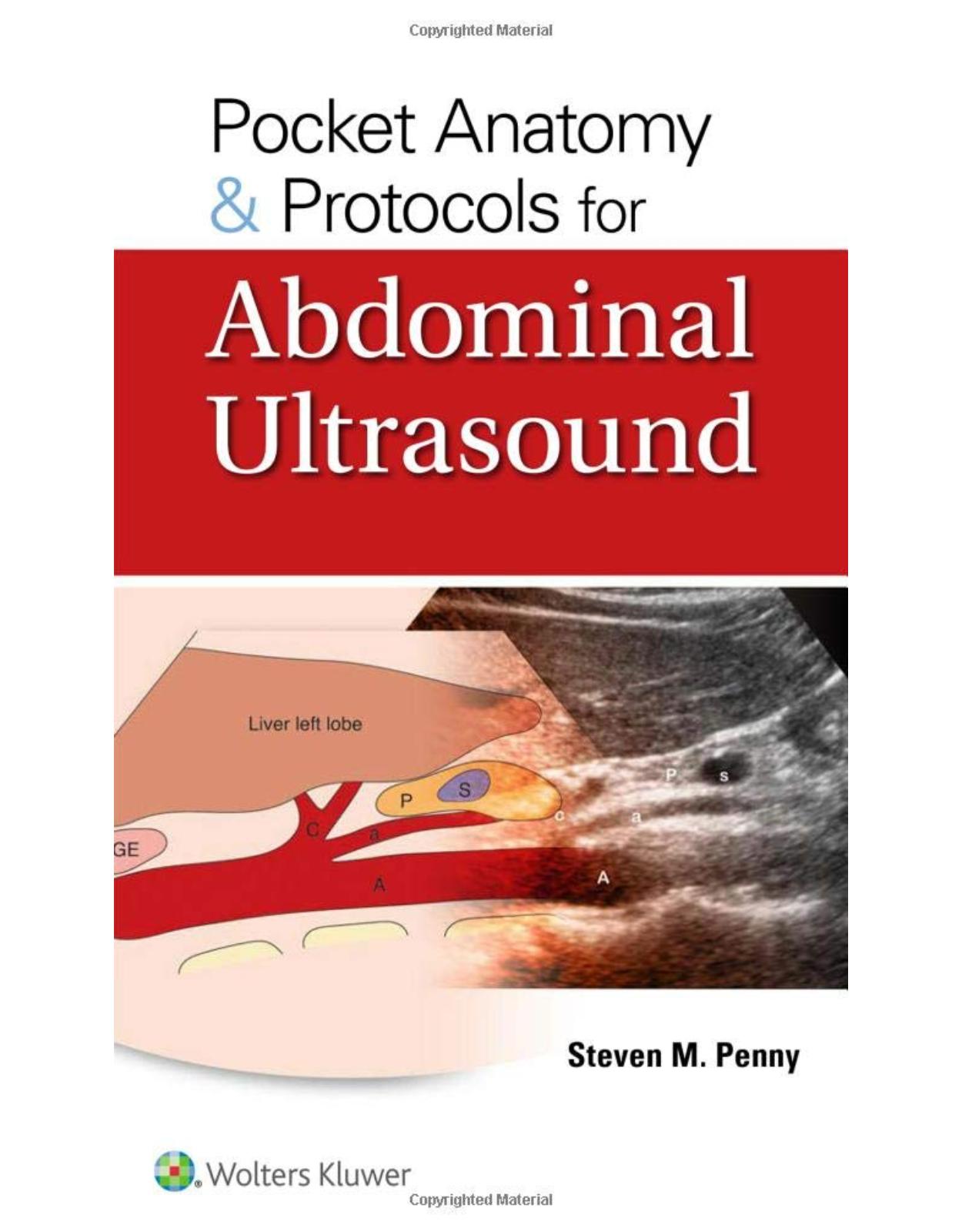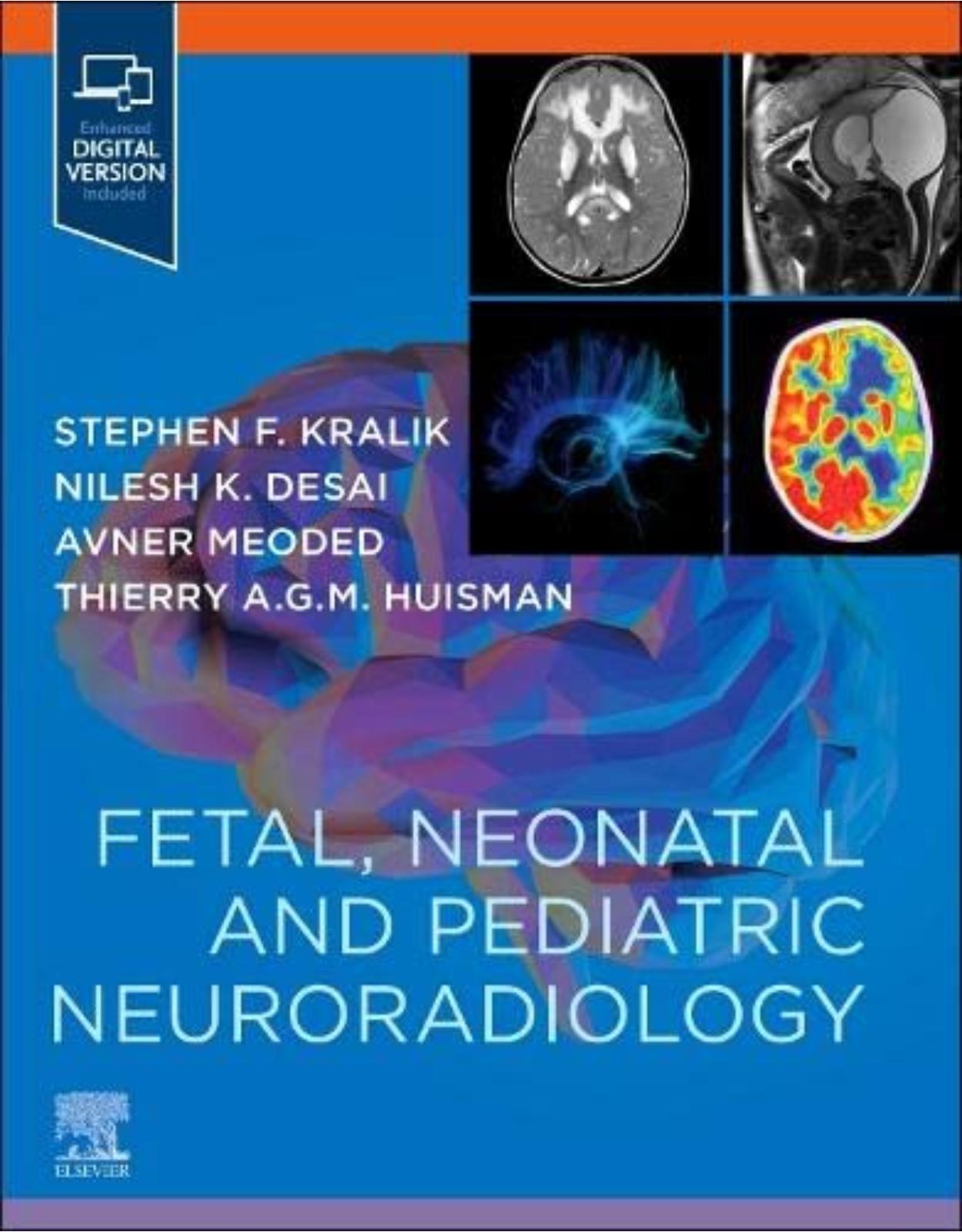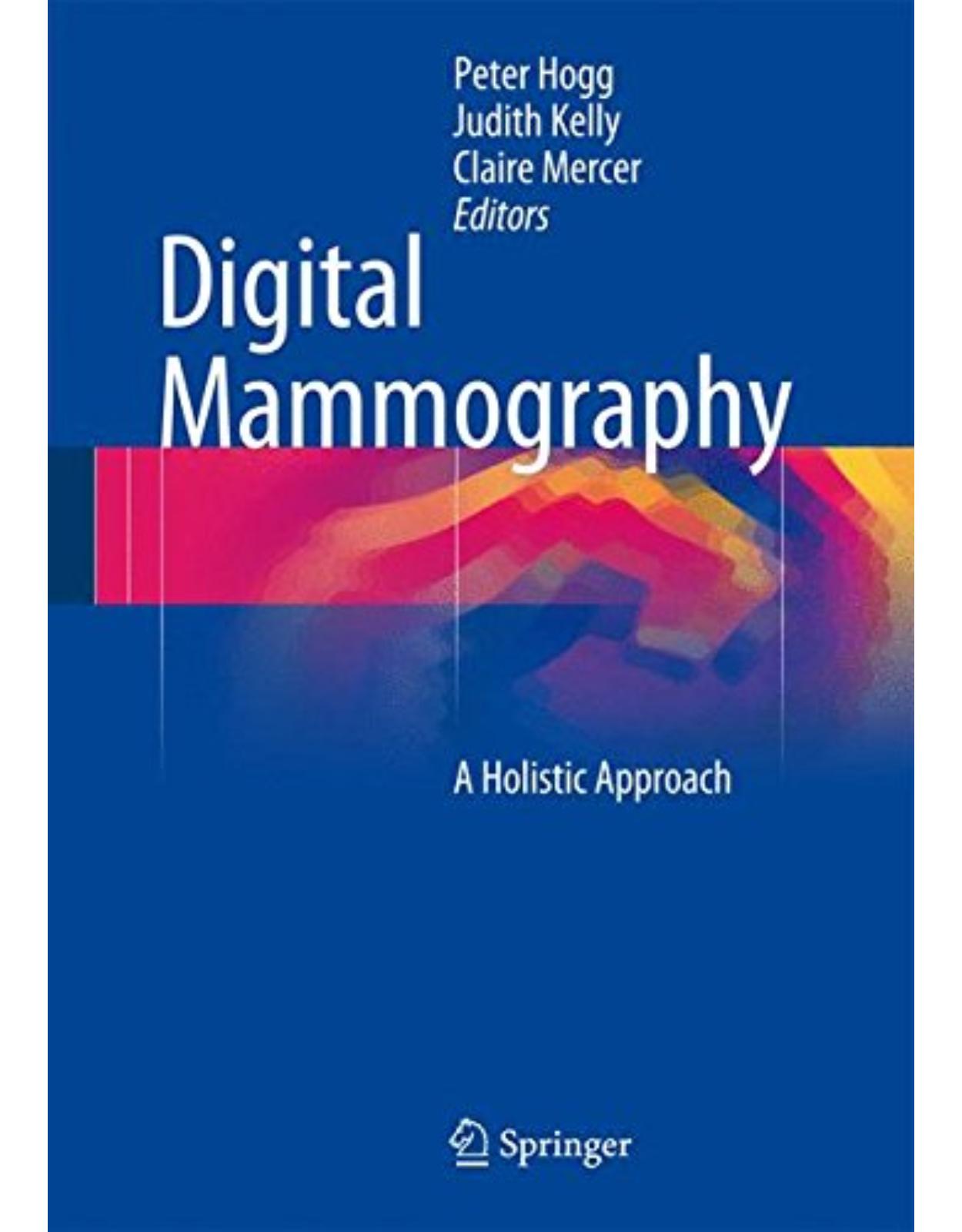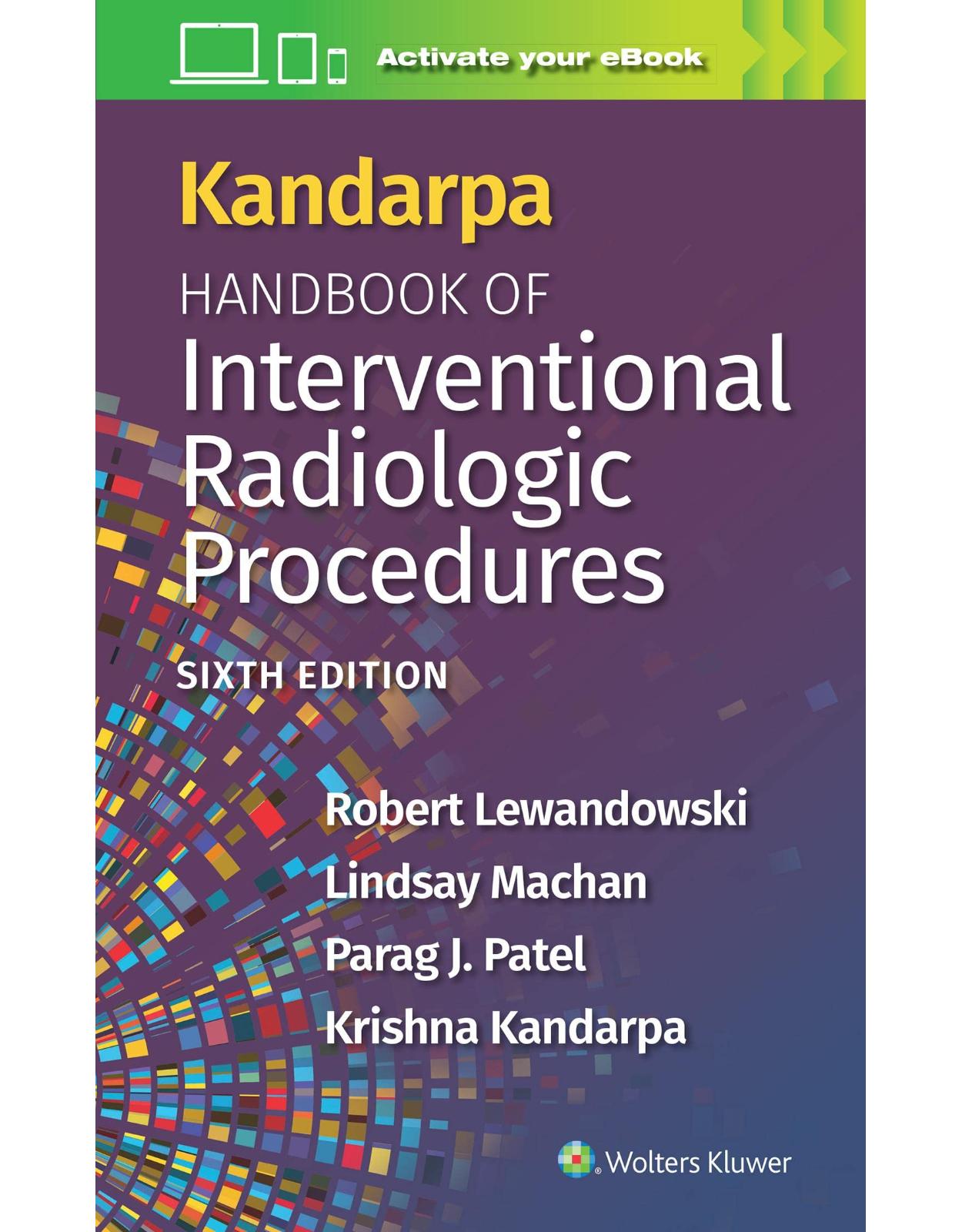
Kandarpa Handbook of Interventional Radiology
Livrare gratis la comenzi peste 500 RON. Pentru celelalte comenzi livrarea este 20 RON.
Disponibilitate: La comanda in aproximativ 4 saptamani
Editura: LWW
Limba: Engleza
Nr. pagini: 832
Coperta: Paperback
Dimensiuni: 127 x 203 mm
An aparitie: 25/06/2023
Description:
Focusing on time-tested protocols, tailored imaging and current procedural equipment, this popular, practical handbook by Drs. Krishna Kandarpa, Lindsay Machan, Robert Lewandowski, and Parag J. Patel features extensive updates to keep you current with rapid growth in the field. Now in brilliant full color throughout, Kandarpa Handbook of Interventional Radiologic Procedures, 6th Edition, is a convenient, easy-access guide to all current radiologic procedures. It’s an ideal resource not only for practicing interventional and general radiologists, but also for fellows and residents in training, IR nurses, and special procedure technologists.
Table of Contents:
SECTION I: VASCULAR ACCESS
1 Gaining Vascular Access
Retrograde Common Femoral Artery Access and Initial Catheterization
Preparation and Puncture
Catheterization
Antegrade Common Femoral Artery Puncture
Postprocedure Management (1)
Prevention and Management of Complications
Injection Rates and Image-Acquisition Programs
Catheter Angiography
Cone-Beam CT
Considerations for Preprocedure Preparation Prior to Gaining Arterial or Venous Access
2 Vascular Closure Devices
Introduction
Indications
Off-Label Uses for Vascular Closure Device
Contraindications
Procedure
Types of Devices
Selected Device Profiles
Advanced Techniques
Complications (Table 2.7)
Results
Key Take-Home Points
3 Management of Vascular Complications
Introduction
Pseudoaneurysms
Indication
Contraindications
Preprocedure Preparation
Procedure
Postprocedure Management
Results (2,3)
Complications (1–3)
Management of Complications (1,3)
Other Access Site Complications (1–5)
Considerations Specific to Radial Access
SECTION II: TRANSARTERIAL PROCEDURES
4 Endovascular Management of Acute Ischemic Stroke
Introduction
Background for EVT
Indications
Contraindications
Absolute
Relative
Preprocedural Preparation
1. Triage, History and Physical Examination
2. Preprocedural Evaluation
3. Imaging Evaluation
Procedure
Postprocedural Management
EVT Procedural Steps for M1 MCA LVO with Primary Combined Approach
Postprocedural Complications
Access Site Complications (2% to 11%)
Neurologic
Cardiac
Respiratory
5 Carotid Artery Stenosis
Introduction
Indications
Contraindications
Preprocedure Workup
Imaging
Procedure Preparation
Intraprocedural Medications
Blood Thinners
Management of Intraprocedural Bradycardia
Intra-Arterial Antihypertensive Medications and Vasospasm Treatment
Management of Hypotension
Equipment
Procedure in Detail
Postprocedure Management
Follow-Up
Complications and Management
Data from Randomized Controlled Trials
6 Vascular Emergencies of the Head and Neck
Introduction
Neurologic and Neurosurgical Disorders
Intracranial Subarachnoid Hemorrhage (SAH) (3)
Clinical Presentation
Noninvasive Imaging
Treatment for Ruptured Intracranial Saccular Aneurysm (4,5)
Treatment of Cerebral Vasospasm (6)
Nontraumatic Cerebral Parenchymal Hemorrhage (IPH) (7)
Otorhinolaryngologic (ENT) Emergencies
Epistaxis (8)
Traumatic Vascular Injuries (9)
Malignant Disease of the Head and Neck (10)
7 Renovascular Hypertension: Endovascular Management
Introduction (1)
Renovascular Hypertension
Indications for Revascularization (4)
Ischemic Nephropathy
Indications for Revascularization (3,4)
Renovascular Hypertension, Ischemic Nephropathy, or Both, with Any of the Following Conditions
Indications (3–6)
Contraindications to Renal Revascularization (3–6)
Renal Artery Balloon Angioplasty
Equipment Suggestions
Preprocedure Preparation
Procedure (Figs. 7.1 and 7.2)
Renal Artery Stenting
Indications (3)
Contraindications (3)
Equipment Suggestions
Preprocedure Preparation
Procedure
Postprocedure Management
Results—Percutaneous Revascularization (3–5,11)
Complications
Renal Artery Denervation (2)
Acknowledgment
8 Acute Mesenteric Ischemia
Introduction
Indications
Contraindications
Preprocedure Preparation and Evaluation
Procedure
Postprocedure Management
Results
Complications
9 Acute Gastrointestinal Hemorrhage
Introduction
Indications
Contraindications
Absolute
Relative
Preprocedure Preparation
Procedure
Postprocedure Management
Results
Complications
Management of Complications
10 Aortoiliac Interventions
Introduction
Indications
Contraindications
Preprocedure Preparation
Procedure
Diagnostic Arteriogram
Techniques General to All Interventions
Angioplasty Technique
Stent Placement Technique (Fig. 10.1)
Available Stents
Stent Selection
Special Situations
Postprocedure Management
Results
Intervention, Medical Therapy, and Exercise
Stenting versus Angioplasty
Covered Stent Grafts versus Bare-Metal Stents
Complications and Management
11 Superficial Femoral Artery Interventions
Introduction
Indications
Contraindications
Preprocedure Preparation
Procedure
Postprocedure Management
Results
Complications
Management of Complications
12 Infrapopliteal Arterial Interventions
Introduction
Definition of Critical Limb Ischemia
Differential Diagnosis
Pain
Foot Ulceration
Indications
Contraindications
Absolute
Relative
Preprocedure Preparation
Procedure
Postprocedure Management
Results
Complications
13 Acute Limb Ischemia: Pharmacomechanical and Thrombolytic Therapy
Intraarterial Catheter-Directed Thrombolytic Therapy
Indications
Contraindications (1–4)
Absolute
Relative
Preprocedure Preparation
Procedure
Postprocedure Management
Results
Complications
Management of Complications During Lytic Agent Infusion
Mechanical Thrombectomy in Acute Limb Ischemia
14 Trauma Management
Introduction
Trauma Care in the Interventional Radiology Space
Hemorrhagic Shock
Contraindications
Assessment of the Trauma Patient
Procedure
Longitudinal Management
Indications
Procedure
Results
Complications
Indications
Procedure
Results
Indications (27,28)
Contraindications
Procedure
15 Thoracic Aortic Aneurysms and Dissections
Introduction
Thoracic Aortic Aneurysm (1–4)
Aortic Dissection (2–4)
Stent-Grafts
Goals of Thoracic Endovascular Aortic Repair
Indications (1–4)
Contraindications (1–4)
Absolute
Relative
Preprocedure Imaging
Measurement Techniques and Imaging Assessment
Selection Criteria for Endograft Repair
Anatomic Criteria
Preprocedure Preparation (1–4)
Device Selection for Descending Thoracic Aortic Aneurysms
Device Selection for Complicated Acute Type B Aortic Dissections
Special Considerations
Procedure
Vascular Access
Descending Thoracic Aortic Aneurysms
Complicated Acute Type B Aortic Dissections
Postprocedure Management
Immediate
Follow-up Imaging Surveillance (1–4)
Results
Descending Thoracic Aortic Aneurysms
Complicated Acute Type B Aortic Dissections (2)
Uncomplicated Type B Aortic Dissections
Complications (1–4,10)
Early
Late
16 Pulmonary Vascular Malformations
Introduction
Indications
Contraindications
Association of PAVM with Hereditary Hemorrhagic Telangiectasia (3,6)
Pathology of PAVM (4)
Clinical Manifestations of PAVM and Fistula (2,3)
Embolotherapy for Pulmonary Arteriovenous Malformation and Fistula
Preprocedure Evaluation: Diagnostic Evaluation for PAVM
Periprocedural Considerations
Procedure (2)
Posttreatment Care
Results (2–4)
Complications and Side Effects
Alternative Treatments for Pulmonary Arteriovenous Malformation
17 Stent-Grafts for Abdominal Aortic Aneurysms
Introduction
Goals of Stent-Graft Therapy
Indications
Contraindications
Preprocedure Imaging
Selection Criteria for Endograft Repair
Anatomic Criteria
Procedure
Postprocedure Management
Results
Complications
Management of Complications
18 Management of Stent-Graft Endoleaks
Endovascular Aortic Aneurysm Repair and Endoleaks
Endoleak Classification (see Table 18.1)
Post-EVAR Imaging Modalities
Surveillance and Management Strategies
Endoleak Treatment
Special Considerations
19 Visceral Aneurysms
Introduction
Etiology (3)
Indications
Contraindications
Absolute
Relative
Preprocedure Preparation
Procedure
Embolization Strategies
Organ-Specific Comments
Postprocedure Management
Results
Complications and Their Management
20 The Management of Extracranial Vascular Malformations
Introduction
High-Flow Malformation: AVM
Indications
Contraindications
Absolute
Relative
Preprocedure Imaging and Preparation
Preprocedural Imaging
Preprocedural Preparation
Procedure
General Principles of AVM Embolization
Arterial Endovascular Approach
Nidus Direct Puncture
Retrograde Venous Approach
How to Choose and Manipulate the Embolic Agent
Combining Ethanol with Glue or Onyx
Anatomic Consideration
Renal AVM
Postprocedure Management
Results
Patient Follow-Up
Complications
Management of Complications
Low-Flow Malformations: Venous (VMs) and Lymphatic Malformations (LMs)
Introduction
Indications
Preprocedure Preparation and Imaging
Preprocedural Imaging
Preoperative Preparation
Procedure
Venous Malformation
Lymphatic Malformation
Sclerosant Agents
Detergents
Ethanol
Bleomycin
Doxycycline
Complications
Management of Complications
21 Hepatic Metastases: Chemoembolization
Indications
Contraindications
Preprocedure Preparation
Pretreatment Assessment
Patient Education
Patient Preparation
Procedure
Postprocedure Management
Results
Complications
22 Hepatocellular Carcinoma: Chemoembolization
Introduction
Indications
Contraindications
Absolute
Relative
Preprocedure Preparation
Procedure
Follow-Up
Results
Complications
Management of Complications
Summary
23 Hepatic Malignancies: Radioembolization
Introduction
Indications
Contraindications
Absolute
Relative
Preprocedure Preparation
Procedure
Postprocedure Management
Results
Adverse Events
Management of Complications
24 Uterine Fibroid Embolization
Introduction
Indications
Contraindications
Absolute
Relative
Preprocedure Preparation
Procedure
Uterine Artery Catheterization
Embolization Technique
Postprocedure Management
Results
Complications
Management of Complications
25 Splenic and Renal Embolization
Introduction
Indications
Contraindications
Absolute
Relative
Preprocedure Preparation
Procedure
Postprocedure Management
Results
Complications
Management of Complications
26 BPH: Prostatic Artery Embolization
Indications
Contraindications
Absolute
Relative
Preprocedure Preparation
Procedure (3,4)
Postprocedure Management
Results (2,4,8,10)
Complications and Management (9)
SECTION III: TRANSVENOUS PROCEDURES
27 Temporary Central Venous Access: Peripherally Inserted Central Catheters and Nontunneled Central Venous Catheters
Introduction
Indications (2)
Contraindications
Absolute
Relative
Preprocedure Preparation
Procedure
General Considerations
PICC Line Placement
Central Venous Catheter Placement
Device Removal
Postprocedure Management
Results
Complications
Management of Complications
Malposition
Pneumothorax
Air Embolus
Great Vessel or Cardiac Perforation
28 Long-Term Central Venous Access: Tunneled Catheters and Subcutaneous Ports
Introduction
Indications (2)
Contraindications
Absolute (1)
Relative (1)
Preprocedure Preparation
Procedure
General Considerations
Tunneled Central Venous Catheters
Chest Port
Device Removal
Exchanging a Nonfunctioning Tunneled Catheter
Postprocedure Management
Results
Complications
Management of Complications
29 Central Venous Access Management
Introduction
Site Care
Catheter Evaluation
Catheter Malfunction
30 Dialysis Fistulae
Introduction
Indications (for Diagnostic Imaging and Intervention)
Contraindications
Absolute
Relative
Preprocedural Preparation
Procedure
Fistulography and Percutaneous Transluminal (Balloon) Angioplasty for Nonmaturing Fistulae
Fistulography and PTA for Failing AVFs
Clearing of Thrombus from Occluded AVFs (“Declotting Procedure”)
Postprocedural Management
Results
Complications
Major
Minor
Management of Complications
31 Dialysis Grafts
Introduction
Indications
Contraindications
Absolute
Relative
Preprocedural Preparation
Procedure
Fistulography and Angioplasty for Failing AVGs
Clearing of Thrombus from Occluded AVGs (Declotting Procedures)
Postprocedural Management
Results
Complications and Management of Complications
32 Dialysis Catheter Management
Introduction
Indications
Contraindications
Absolute
Relative
Preprocedure Preparation
Basic Considerations
Selection of Catheter Insertion Site
Evaluation of Catheter Insertion Site
Selection of a Hemodialysis Catheter
Procedure
Insertion of Tunneled Hemodialysis Catheter
Removal of a Tunneled Hemodialysis Catheter
Exchange of a Tunneled Hemodialysis Catheter
Postprocedure Management
Results
Complications/Management
33 Venography
Introduction
Indications
Lower Extremity Venography
Upper Extremity Venography
Contraindications
Relative
Preprocedure Preparation
Procedure
Lower Extremity Ascending Venography (4,5)
Upper Extremity Venography (7)
CO2 Venography (7,8)
Postprocedure Management
Results
Complications
34 Pulmonary Embolism: Endovascular Interventions
Introduction
Diagnosis of Pulmonary Embolism
Treatment of Pulmonary Embolism
Pulmonary Thrombolysis and Thrombectomy
Indications
Contraindications
Preprocedure Preparation
Procedure
Venous Access
Selective Catheters
Measure Right Heart Pressures
Arteriographic Technique
Catheter-Directed Thrombolysis
Catheter Thrombectomy, Aspiration, and Maceration
Postprocedure Management
Catheter-Directed Thrombolysis
Catheter Thrombectomy, Aspiration, and Maceration
Data and Complications
Catheter-Directed Thrombolysis
Catheter Thrombectomy, Aspiration, and Maceration
Chronic Pulmonary Thromboembolic Disease
Conclusions
35 Vena Caval Filters
Introduction
Filter Placement
Indications
Contraindications
Preprocedure Preparation
Procedure
Postprocedure Management
Results
Complications
Management of Complications
Optional Filter Retrieval or Mechanical Conversion
Indications
Contraindications
Preprocedure Preparation
Procedure
Postprocedure Management
Results (11)
Complications (11,12)
Management of Complications (11,12)
36 Acute Extremity DVT: Thrombectomy and Thrombolysis
Introduction
Indications
Contraindications
Preprocedure Preparation
Procedure
Postprocedure Management
Results
Complications
37 Endovascular Management of Chronic Deep Venous Obstructive Disease
Introduction
Chronic Lower Extremity Deep Venous Disease
Chronic Upper Extremity Deep Venous Disease/Thoracic Central Venous Obstruction
Indications
Postthrombotic Lower Extremity Deep Venous Obstruction
Nonthrombotic Lower Extremity Deep Venous Obstruction
Thoracic Central Venous Obstruction
Contraindications
Preprocedure Preparation
Postthrombotic Lower Extremity Deep Venous Obstruction
Nonthrombotic Lower Extremity Deep Venous Obstruction
Thoracic Central Venous Obstruction
Procedure
Postthrombotic Lower Extremity Deep Venous Obstruction
Variations to the Procedure for Nonthrombotic Lower Extremity Deep Venous Obstruction
Variations to the Procedure for TCVO
Postprocedure Management
Results
Complications
38 Transvenous Biopsy
Introduction
Indications
Contraindications
Relative
Preprocedure Preparation
Procedure
Transvenous Biopsy of Perivascular/Retroperitoneal Tumors (6)
Postprocedure Management
Results
Complications
Management of Complications
39 Preoperative Hepatic Augmentation
Introduction
Indications
Contraindications
Absolute
Relative
Preprocedure Preparation
Procedure
Variations
Postprocedure Management
Results
Complications
40 Transjugular Intrahepatic Portosystemic Shunts
Introduction
Indications (1–5)
Contraindications
Absolute
Relative
Preprocedure Preparation
Procedure
Postprocedure Management
Results
Complications
Management of Complications
41 Retrograde Transvenous Obliteration of Varices
Introduction
Indications
Contraindications
Absolute
Relative
Preprocedure Preparation
Procedure
Balloon-Occluded Retrograde Transvenous Obliteration (Fig. 41.2)
Plug/Coil-Assisted Retrograde Transvenous Obliteration (PARTO/CARTO) (Fig. 41.3)
Postprocedure Management
Results (8–10)
Complications
42 Varicocele Embolization
Introduction (1,2)
Indications (5,6)
Contraindications
Preprocedure Preparation
Procedure (2,5)
Postprocedure Management
Results (2,7)
Complications
43 Ovarian and Pelvic Vein Embolization
Introduction (1–3)
Indications
Contraindications
Preprocedure Preparation
Pretreatment Assessment (4,5)
Patient Preparation
Procedure (6–8)
Postprocedure Management
Complications
Results (9,10)
44 Thermal and Nonthermal Saphenous Vein Ablation
Introduction
Thermal versus Nonthermal Ablation
Anatomy of Superficial Veins of the Leg
Indications
Contraindications
Absolute
Relative
Preprocedural Evaluation
Preprocedure Preparation
Procedure
Thermal Ablation
VenaSeal Cyanoacrylate Closure
Mechanicochemical Ablation
Polidocanol Endovenous Microfoam (Varithena)
Postprocedure Management
Results
Complications
45 Varicose, Perforator, and Spider Veins: Liquid Ablation and Microphlebectomy
Introduction (1,2)
Sclerotherapy
Indications (1,3)
Contraindications
Preprocedure Preparation
Procedure (2,4)
Postprocedure Management
Results
Complications (7)
Management of Complications (8)
Microphlebectomy
Indications
Contraindications (9)
Preprocedure Preparation
Procedure (9)
Postprocedure Management
Results
Complications (8,10)
Management of Complications
SECTION IV: NONVASCULAR PROCEDURES
46 Biopsy Procedures of the Lung, Mediastinum, and Chest Wall
Indications
Contraindications
Preprocedure Preparation
Procedure
Postprocedure Management
Results
Complications
Common
Infrequent
Rare
47 Catheter Drainage of Intrathoracic Collections
Introduction
Indications
Contraindications
Choice of Drainage Catheter (1–3,5–8)
Preprocedure Preparation
Technique
Malignant Pleural Effusion (1–3,5,8)
Parapneumonic Effusions and Empyema (2,5–7,9,10)
Lung Abscess (2,5,6,7,10)
48 Lymphatic Interventions
Introduction
Indications for TDE
Contraindications
Absolute
Relative
Preprocedure Preparation
Procedure
Postprocedure Management
Results
Complications
Management of Complications
49 Percutaneous Abdominal Biopsy
Introduction
Indications
Contraindications (1)
Preprocedure Assessment and Patient Preparation
Procedure
Intraprocedure Preparation
Procedure (1)
Postprocedure Management
Pathology Results
Adverse Events
Genomics (10)
50 Drainage of Abdominal Abscesses and Fluid Collections
Introduction
Indications
Contraindications
Absolute (1,2)
Relative (1,2)
Preprocedure Preparation
Imaging Guidance
Procedure
Complications
Major (1)
Minor (1)
Catheter Care
Catheter Removal
Results
51 Percutaneous Gastrostomy, Percutaneous Gastrojejunostomy, Jejunostomy, and Cecostomy
Percutaneous Enteral Tubes
Types of Tubes
Percutaneous Gastrostomy
Indications (1–5)
Contraindications (1–5)
Preprocedure Preparation
Procedure
Postprocedure Management
Results
Complications
Percutaneous Gastrojejunostomy
Conversion of a Mature PG Tube to PGJ Tube
Primary Placement of a PGJ Tube
Percutaneous Jejunostomy
Percutaneous Cecostomy
52 Percutaneous Biliary Interventions
Introduction
Preprocedural Preparation
Percutaneous Transhepatic Cholangiography (PTC)
Indications
Contraindications
Procedure
Postprocedure Management
Success Rate
Complications and Their Management
Percutaneous Transhepatic Biliary Drainage (PTBD)
Indications
Contraindications
Procedure
Postprocedure Management
Success Rate
Complications and Management of Complications
Percutaneous Transjejunal Cholangiography and Endoscopy
Indications
Contraindications
Procedure
Postprocedure Management
Success Rate
Complications and Management of Complications
Biopsy
Brush Biopsy
Endoscopic
Percutaneous Fluoroscopic/Ultrasound-Guided Biopsy
Percutaneous Cholangioplasty
Indications
Contraindications
Procedure
Postprocedure Management
Success Rate
Complications and Management of Complications
Percutaneous Stent Placement
Indications
Contraindications
Procedure
Postprocedure Management
Success Rate
Complications and Management of Complications
Pediatric Biliary Interventions
Combined Procedures
Percutaneous Cholecystostomy (PC)
Indications
Contraindications
Procedure
Postprocedure Management
Success Rate
Complications and Management of Complications
53 Percutaneous Nephrostomy and Antegrade Ureteral Stenting
Introduction
Indications (1–4)
Contraindications
Absolute
Relative
Specific to Antegrade Ureteral Stents
Preprocedure Preparation
Procedure
Percutaneous Nephrostomy
Nephroureterostomy (Nephroureteral Stent) Placement
Antegrade Ureteral Stent Placement
Retrograde Nephrostomy
Removal or Exchange of PCN or Nephroureterostomy
Exchange of Ureteral Stents
Postprocedure Management
Results
Complications and Management (1–4)
Major: 4.0%
Minor: 15%, Usually Without Sequelae
Complications Specific to Antegrade Ureteral Stent Placement
54 Lymphocele and Cyst Drainage and Sclerosis
Introduction
Indications
Contraindications
Absolute
Relative
Preprocedure Preparation
Procedure
Diagnosis
Aspiration and Drainage
Sclerotherapy
Postprocedure Management
Results
Complications
Major
Minor
55 Pulmonary Tumor Ablation
Introduction
Lung Cancer
Indications
Biopsy-Proven Malignancy
Contraindications
Absolute
Relative
Preprocedure Preparation
Procedure
Postprocedure Management
Results
Complications and Management
56 Hepatic Tumor Ablation
Introduction
Indications
Contraindications
Preprocedure Preparation
Procedure
Postprocedure Management
Results
Complications
57 Renal Tumor Ablation
Introduction
Indications
Contraindications
Absolute
Relative
Preprocedure Preparation
Procedure
Postprocedure Management
Results
Complications
Management of Complications
58 Musculoskeletal Biopsies, Aspirations, and Injections
Biopsies
Introduction
Indications
Contraindications
Absolute
Relative
Preprocedure Preparation
Procedure
Postprocedure Management
Results
Complications
Management of Complications
Joint Injections and Aspirations
Introduction
Indications
Contraindications
Preprocedure Preparation
Procedure
Postprocedure Management
Results
Complications
Management of Complications
Soft Tissue Aspiration and Sclerosis
Introduction
Indications
Contraindications
Preprocedure Preparation
Procedure
Postprocedure Management
Results
Complications
Management of Complications
59 Musculoskeletal (MSK) Ablation
Introduction
Radiofrequency Ablation (RFA)
Microwave Ablation (MWA)
Cryoablation (CA)
Combination Procedures
Indications
Contraindications
Preprocedure Preparation
Procedure
Postprocedure Management
Results
Complications
Management of Complications
60 Osteorestorative Techniques
Overview
61 Musculoskeletal Pain and Palliative Procedures
Spinal Injections
Introduction
Indications
Contraindications
Preprocedure Preparation
Procedure
Postprocedure Management
Results (1)
Complications
Management of Complications
Palliative Nerve Blocks, Neurolysis, and Ablations
Ganglion Blocks/Neurolysis
Contraindications
Preprocedure Preparation
Procedure
Postprocedure Management
Results
Complications
Management of Complications
Sympathetic Neurolysis (9)
Introduction
Indications
Contraindications
Preprocedure Preparation
Procedure
Postprocedure Management
Results
Management of Complications
Peripheral Nerve Blocks (PNB) and Neurolysis
Introduction
Indications
Contraindications
Preprocedure Preparation
Procedure (Figs. 61.9 to 61.11)
Postprocedure Management
Results
Management of Complications
SECTION V: INTRAPROCEDURAL PATIENT MANAGEMENT
62 Safety in IR
Introduction
Universal Protocol
Indications
Exemptions to Universal Protocol
Preprocedure Verification
Site Marking
Time-Out
Documentation
63 Sedation, Analgesia, and Anesthesia
Introduction
Analgesia and Anesthesia: Options and Indications
Patient Evaluation
Recommended Monitoring (Table 63.1)
Required Resuscitation Equipment
Medication Prior to Procedure
Techniques of Sedation, Analgesia, and Anesthesia During the Procedure
Local Anesthesia
Local Anesthesia with Sedation/Analgesia
Neuraxial Anesthesia
General Anesthesia
Other Procedural Considerations
Postprocedure Management
64 Drug Administration
Preprocedural Considerations
Procedural Considerations
Recovery and Postprocedure Care
Dosage Calculations
Units (Table 64.1)
Calculating Infusion Doses
65 Contrast Media Reactions: Treatment and Risk Reduction
General Principles (1,2)
Know the Patient
Recognize That There Is a Problem
Be Prepared to Deliver Treatment Quickly and Call for Help Early
Treatment of Adverse Reactions (Table 65.1)
Prophylaxis for Contrast Media Reactions (8)
66 Contrast-Induced Nephropathy: Prevention and Management
Introduction
Pathophysiology
Diagnosis
Incidence
Natural History
Risk Factors
Patient Preparation
Prophylaxis
The Role of Specific Contrast Agents
Other Considerations
SECTION VI: NONINVASIVE EVALUATION AND DIAGNOSTIC IMAGING
67 Noninvasive Physiologic Evaluation: Lower Extremity Arteries
Segmental Pressure Measurements of the Lower Extremity: Ankle–Brachial Index and Stress Testing
Indications (1,2)
Contraindications
Preprocedure Preparation
Procedure
Postprocedure Management
Results
Complications
Limitations and Artifacts
Pulse Volume Recordings
Indications
Contraindications
Preprocedure Preparation
Procedure
Results (6,7)
Complications
68 Duplex Ultrasound Imaging of Carotid and Peripheral Arteries
Carotid Artery Disease
Indications
Contraindications
Preprocedure Preparation
Procedure
Postprocedure Management
Results
Complications
Peripheral Arterial Disease
Indications
Contraindications
Preprocedure Preparation
Procedure
Postprocedure Management
Results
Complications
Lower Extremity Bypass Grafts
Indications
Contraindications
Pre-Procedure Preparation
Procedure
Postprocedure Management
Results
Complications
69 Duplex Ultrasound of the Abdominal Vasculature
Introduction
Abdominal Aortic Aneurysm
Transjugular Intrahepatic Portosystemic Shunt
Liver Transplant Evaluation
Renal Transplant Evaluation
Renal Artery Evaluation
Visceral Artery Evaluation
70 Color Doppler and Ultrasound Imaging of Peripheral Veins
Veins of the Lower Extremity
Indications
Contraindications
Preprocedure Preparation
Detection of Deep Vein Thrombosis
Saphenous Vein Mapping Prior to Infrainguinal Bypass Procedures (5–7)
Detection and Segmental Evaluation of Venous Reflux
Veins of the Upper Extremity
Indications
Contraindications
Preprocedure Preparation
Procedure
Postprocedure Management
Results (10)
Complications
71 Magnetic Resonance Angiography
Introduction
Preprocedure Preparation
Procedure
Standard MRA Examinations (see also Appendix D for Common Protocols)
72 Computed Tomographic Angiography
Choice of Appropriate Modality
Preprocedure Preparation
Procedure (see Appendix E for Common CTA Protocols)
APPENDICES
Appendix A: Vascular Anatomy
Pulmonary Artery Segmental Branches
Abdominal Aorta
Common Locations of Abdominal Aortic Branches
Arteries of the Pelvis
Collateral Pathways in Aortoiliofemoral Occlusive Disease
Common Collateral Pathways
Arteries of the Upper Extremity
Intracranial Arteries
Appendix B: Nursing Checklist
Preprocedure Nursing Evaluation Checklist
Appendix C: Hemodynamic Monitoring and Cardiovascular Pressures
Right Heart Catheterization
Technique
Complications
Right Heart and Pulmonary Artery Pressure Waveforms
Left Heart Catheterization
Technique
Complications
Left Heart and Aortic Pressure Waveforms
Clinical Significance of Waveforms
Right Atrial Pressure
Right Ventricular Pressure
Pulmonary Arterial Pressure
Pulmonary Capillary Wedge Pressure/Left Atrial Pressure
Left Ventricular Pressure
Aortic Pressure/Systemic Arterial Pressure
Respiratory Effects
Appendix D: Common Magnetic Resonance Angiography Protocols
Appendix E: Computed Tomographic Angiography
Commonly Used Protocols for Standard Computed Tomographic Angiography Examinations
Appendix F: Contrast Media Table
Appendix G: Carotid Stenting Data Tables
INDEX
e-73 Radionuclide Evaluation for Interventional Radiologists
Ventilation–Perfusion Pulmonary Scintigraphy
Indications
Precautions
Preprocedure Preparation
Procedure
Postprocedure Management
Results (1)
Complications
Gastrointestinal Bleeding Studies
Indications
Precautions/Limitations
Preprocedure Preparation
Procedure (2)
Results (2)
Captopril-Enhanced Renal Scintigraphy for Diagnosis of Renovascular Hypertension
Indications
Contraindications
Preprocedure Preparation
Procedure
Postprocedure Management
Results
Complications
Diuretic Renal Scintigraphy
Indications (9)
Contraindications
Preprocedure Preparation
Procedure
Postprocedure Management
Results
Limitations
e-74 PET/CT for Oncologic Interventions
Introduction
PET/CT Imaging with 18F-FDG
Indications
Contraindications
Patient Preparation
Procedure
PET/CT Tumor Treatment Assessment
Hepatocellular Cancer, Intrahepatic Cholangiocarcinoma, and Hepatic Metastases
Lung Cancer
Bone Tumors
Renal Cell Cancer
Conclusion
e-75 Clinical Evaluation of the Cancer Patient
Patient Assessment
Patient Triage
Patient Follow-Up
e-76 Cancer Imaging for Interventional Radiologists
Introduction
Lung Cancer
Hepatocellular Carcinoma
Hepatic Metastasis
Renal Cell Carcinoma
Adrenal Metastasis
Pancreatic Cancer
SECTION VII: SPECIAL INTERVENTIONS
e-77 Pediatric Angiography
Preprocedure Preparation (1)
Procedure (1)
Postprocedure Management
Complications
Prevention and Management of Complications (4)
e-78 Bronchial Artery Embolization
Introduction
Indications
Contraindications
Absolute
Relative
Preprocedure Preparation
Procedure
Postprocedure Management
Results
Complications
e-79 Tracheobronchial Stents
Introduction
Indications
Contraindications
Preprocedure Preparation
Anatomy
Stent Properties
Procedure
Postprocedure Management
Results
Complications
Management of Complications
Appendix
Nature of the Problem
Recommendations
Reporting Adverse Events to FDA
e-80 Esophageal Stents
Introduction
Indications
Contraindications
Relative
Preprocedure Preparation
Procedure
Stent Placement (Fig. e-80.1A–F)
Stent Removal (Fig. e-80.2A–F)
Postprocedure Management
Postplacement
Postretrieval
Results
Malignant Esophageal Strictures
Benign Esophageal Strictures
Management of Complications
e-81 Gastroduodenal Stent Placement
Introduction
Indications
Contraindications
Relative
Preprocedure Preparation
Procedure
Postprocedure Management
Results
Technical Success
Clinical Success
Complications and Management
e-82 Colorectal Stent Placement
Introduction
Indications (2)
Contraindications (2,10)
Preprocedure Preparation
Procedure (2,10)
Postprocedure Management (2,10)
Results
Technical Success
Clinical Success
Complications and Management
e-83 Retrieval of Intravascular Foreign Bodies
Introduction
Indications
Contraindications
Absolute
Relative
Preprocedure Preparation
Procedure
Postprocedure Management
Results
Complications
Management of Complications
e-84 Liver Transplant Management
Introduction
Indications (1,2,4–6)
Contraindications
Relative
Preprocedure Preparation
Procedure
Hepatic Artery Interventions
Venous Outflow Interventions
Portal Venous Interventions
Portal Hypertension (3,10)
Postprocedure Management
Results (1,3,5–8)
Complications/Management (1,5–8)
e-85 Selective Salpingography and Fallopian Tube Recanalization
Indications
Diagnostic Selective Salpingography (1,2)
Therapeutic Fallopian Tube Recanalization (3)
Contraindications
Absolute
Relative
Preprocedure Preparation
Pretreatment Assessment
Patient Education
Patient Preparation
Procedure (2,5)
Postprocedure Management
Complications
Results (6,7)
Technical Success
Pregnancy
e-86 Endovascular Management of Obstetric Hemorrhage
Introduction
Indications
Contraindications
Preprocedure Preparation
Procedure
Postprocedure Management
Results
Complications
Prevention and Management of Complications
e-87 Peritoneal Dialysis
Introduction
Indications
Contraindications (1,3)
Absolute
Relative
Preprocedure Preparation
Procedure (5)
Postprocedure Management
Results
Complications (9,10)
Procedural Complications
Late Complications
e-88 Management of Recurrent Ascites
Indications
Paracentesis
Tunneled Peritoneal Catheters
Contraindications
Absolute
Relative for Tunneled Peritoneal Catheters Specifically
Preprocedure Preparation
Tunneled Peritoneal Catheter Placement
Postprocedure Management
Results
Complications and Management
Paracentesis (8)
Peritoneal Catheter
e-89 Adrenal Vein Sampling
Introduction (1–7)
Indications
Absolute Contraindications
Preprocedure Preparation
Procedure
Postprocedure Management
Results (2,8)
Complications
Management of Complications
e-90 Genicular Artery Embolization
Introduction
Indications
Contraindications
Absolute
Relative
Preprocedure Preparation
Procedure
Room and Patient Preparation
Femoral Artery Access
Catheterization
Postprocedure Management
Results
Complications and Management
SECTION VIII: MATERIALS AND METHODS
e-91 Intravascular Contrast Media
Patient Evaluation Prior to Contrast Administration: Areas Requiring Specific Attention (1–4)
Principles for Intravascular Contrast Agent Administration (1–6)
Reactions to Intravascular Contrast Agents
Steps to Prevent Contrast Reactions
Alternatives to Iodinated Contrast Agents
e-92 Angiographic Equipment Selection and Configuration
Imaging Equipment for Angiography
Generators
X-Ray Tubes
Patient Tables
Gantry Stands
Displays
Contrast Injector
Image Chain
Image Data Processing
Acceptance Testing and Quality Control
e-93 Standard Angiography/Interventional Procedure Tray Contents
Introduction
Procedure Tray Content
Sterile Table Equipment (see Fig. e-93.1)
Solutions (for Flush/Irrigation)
Personal Protective Equipment
e-94 Needles, Guidewires, Catheters, and Stents
Introduction
Needles
Guidewires
Guidewire Handling
Vascular Catheters
Determination of Flow Rate and Bursting Pressure
Catheters: Technical Facts and Precautions
Nonvascular Catheters
Drainage Catheters
Enteral Drainage Catheters
Gastrostomy, Gastrojejunostomy, and Jejunostomy Catheters
Dilatation Balloons
Stents
Stent Grafts
e-95 Embolization: Materials
Introduction
Indications for Embolization (1)
Mechanical Occlusive Devices
Particulate Embolic Agents
Liquid Embolic Agents
e-96 Commonly Used Medications
Analgesics
Lidocaine Hydrochloride (Xylocaine)
Antibiotics
Background
Organisms and Suggested Antibiotics
Common Procedures
Preprocedural Antibiotics
Anticoagulants (Tables e-96.2 and e-96.3)
Low–Molecular-Weight Heparin (LMWH)
Fondaparinux (Arixtra)
Heparin
Warfarin Sodium (Coumadin)
Direct Thrombin Inhibitor (DTI)
Direct Oral Anticoagulants (DOACs)
Reversal Agents
Antiplatelets
Abciximab (ReoPro)
Acetylsalicylic Acid (Aspirin)
Clopidogrel Bisulfate (Plavix)
NSAIDs
Eptifibatide (Integrilin)
Periprocedural Care (see Tables e-96.2 and e-96.3)
Antiemetics
5-HT3 Receptor Antagonists (Ondansetron [Zofran])
Primary H1 Receptor Antagonist (Promethazine [Phenergan], Hydroxyzine [Atarax], Diphenhydramine [Benadryl], Meclizine [Antivert])
D2-Receptor Antagonist (Prochlorperazine [Compazine], Metoclopramide [Reglan])
Primary Muscarinic Receptor Antagonist (Scopolamine Patch [Transderm Scop])
Antihistamines
Antiinflammatories
Ketorolac Tromethamine (Toradol)
Glucocorticoids (Corticosteroids)
Contrast Reaction Medications (Tables e-96.5 and e-96.6)
Antihistamines (Diphenhydramine)
Beta 2-Adrenergic Receptor (Albuterol)
Glucocorticoids (Corticosteroids)
Opioids (see Table e-96.8)
Fentanyl Citrate (Sublimaze)
Hydromorphone HCl (Dilaudid)
Meperidine Hydrochloride (Demerol)
Morphine Sulfate (MSO4)
Sedatives
Benzodiazepines (see Table e-96.9)
Thrombolytic Agents (Table e-96.10)
Recombinant Tissue Plasminogen Activator (Alteplase)
Tenecteplase (TNKase)
Reteplase (Retavase, Rapilysin)
Urokinase
Vasoconstrictors
Vasopressin (Pitressin)
Vasodilators
Nifedipine (Procardia)
Nitroglycerin (Nitro-Bid IV)
Tolazoline Hydrochloride (Priscoline)
SECTION IX: RISK MANAGEMENT
e-97 Obtaining and Documenting Informed Consent
Introduction
Foundations of the Doctrine of Informed Consent
Obtaining Informed Consent
Essential Elements of Discussion
Documenting the Informed Consent Conversation
Emergency Exception
Practical Tips
Conclusion
e-98 Quality Initiatives and Clinical Practice Guidelines: General Principles
Introduction
Quality Initiatives
History of Quality Improvement
Definition of Quality
Legislation
Clinical Practice Guidelines
History of Clinical Practice Guidelines
Current Development Standards
Quality and Guidelines in the Practice of Interventional Radiology
e-99 Radiation Safety in Interventional Radiology
Primary Safety Principles
Radiation Biology and Radiation Effects
Radiation Dose Measurement
Protecting the Patient (4,7)
Patient Radiation Management (4,7)
Protecting the Operator (1,4,10)
e-100 Infection Control and Sterile Technique in Interventional Radiology
Introduction
Definitions
Aseptic Technique and Environmental Controls
SECTION X: NURSING MANAGEMENT
e-101 Periprocedural Care of the Interventional Radiology Patient
Introduction
Preprocedure Nursing Phone Interview
Procedure Day
Preprocedure Nursing Interview
Preprocedure Preparation by Advanced Practice Provider
Preprocedure Laboratory Studies
Coagulation Testing Guidelines
Preprocedural Review of Systems and Medical History by Advanced Practice Providers
Provider Evaluation
Preprocedure Nurse-to-Nurse Hand-Off
Intraprocedural Nursing Care
Intraprocedural Nurse Monitoring/Care
Continuous Cardiac Monitoring
Maintaining Fluid Balance
Continuous Surveillance of Respiratory Status
Psychosocial Support
Communication/Hand-Off Report to Receiving Department (Inpatient and Outpatient)
Postprocedural Nursing Responsibilities
Discharge Criteria for Outpatient
e-102 Organization and Operation of the Interventional Radiology Clinic
Introduction
Clinical Considerations and Organization of IR Clinic
Service Lines
Scheduling
Clinical Assessment and Coordination of Care
Patient Education
Provider Communication
Operational Considerations
Staffing Considerations
Role of the APP
Infrastructure and Clinic Design
Documentation
Billing and Coding
Building a Referral Network and Practice Promotion
Telehealth
e-103 The Management of External Drainage Catheters
Introduction
The Components of External Drainage Catheter System
Skin Care/Wound Dressing
General Catheter Observations
Flushing the Catheter
Catheter-Related Issues and Considerations
Recording Outputs
Readying the Patient for Discharge
Follow-Up Care
Things Patient Should Bring to Next Appointment
| An aparitie | 25/06/2023 |
| Autor | Robert Lewandowski, Lindsay Machan, Parag Patel, KRISHNA KANDARPA |
| Dimensiuni | 127 x 203 mm |
| Editura | LWW |
| Format | Paperback |
| ISBN | 9781975146269 |
| Limba | Engleza |
| Nr pag | 832 |
| Versiune digitala | DA |

